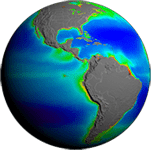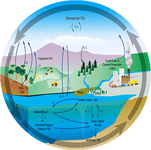Explore NASA PACE Data with ArcGIS
Use ArcGIS to understand our ocean, land and atmosphere
PACE's data is helping us better understand how the ocean and atmosphere exchange carbon dioxide. In addition, it is revealing how aerosols might fuel phytoplankton growth in the surface ocean. Novel uses of PACE data will benefit our economy and society. For example, it will help identify the extent and duration of harmful algal blooms. PACE is extending and expanding NASA's long-term observations of our living planet. PACE's cutting-edge technology is pioneering how we take Earth's pulse for decades to come.






Our ocean teems with life and many of its most vital species are invisible to us. Like on land, the ocean has deserts, forests, meadows, and jungles, providing habitats for many forms of life. The types of life in these habitats is determined by microscopic algae that float in our ocean. Known as "phytoplankton," these tiny organisms come in many different shapes, sizes, and colors. The diversity of phytoplankton types determines the roles they play in ocean habitats. It also determines how well they capture energy from the sun and carbon from the atmosphere.
Read MoreSmall particles suspended in the atmosphere are known as aerosols. Along with clouds, they affect how sunlight is reflected and absorbed by the Earth and its atmosphere. Aerosols and clouds can interact in complex ways, which are not well understood. For example, cloud drops can form on aerosols and aerosols can be washed out of the air by rain. The overall effect of aerosols and clouds on climate is quite uncertain.
Read MoreCarbon exists in forms that range from invisible gases to diamonds. Most life on earth is composed of carbon, as well. In the ocean, a system of physical and biological processes drives the transition between forms of carbon. This system supports life and regulates our planet's livable environment. A key process in the carbon system is photosynthesis and its key players are phytoplankton. These tiny plants and algae convert carbon dioxide gas into organic matter. This organic matter, in turn, supplies food and energy to most life forms in the food web.
Read MoreThe PACE mission is providing a combination of global atmospheric and oceanic observations to benefit society in the areas of water resources, impact of disasters, ecological forecasting, human health, and air quality.
PACE Applications partners with public and private organizations on ways to apply data from PACE and its scientific findings in their decision-making activities and services, helping to improve the quality of life and strengthen the economy.
The U.S. ocean economy contributes over $350B to the GDP (2014) and supports more than 3.1 million jobs (one in 45). Currently, this ocean economy, including the Great Lakes, is growing faster than the total U.S. economy in both contributions to inflation-adjusted GDP (15.6% since 2007 compared to 5.8%) and jobs (8.1% compared to flat).
PACE is the first mission to provide measurements that enable prediction of the boom-bust of fisheries, the appearance of harmful algae, and other factors that affect commercial and recreational industries.
Read More
Phytoplankton provide food for small zooplankton, tiny animals that float in our ocean. Like humans, these grazers actively select their food. In the same way, larger zooplankton prey upon smaller zooplankton. Step by step, energy captured from phytoplankton transfers to bigger creatures. As the energy climbs the marine food web, it can ultimately be used by humans.
The ocean is a fluid that is constantly in motion. Hosting the largest three-dimensional living space on earth, it supports many habitats. For example, the North Atlantic is home to highly productive "forests" each spring. Its blooms of carbon-rich phytoplankton fuel the fisheries of New England. The crystal-clear waters around Florida host productive coral reefs and fisheries. At times, however, this area is plagued by toxic phytoplankton.
Today's satellites reveal the quantity of phytoplankton at the ocean surface. Yet we cannot detect the diversity of species. For the first time, PACE's unprecedented technology:
The Atmospheric Science Data Center (ASDC) has release data for the Plankton, Aerosol, Cloud, ocean Ecosystem Postlaunch Airborne eXperiment ...
Read MoreThe PACE Science Data Segment has initiated the V3.1 processing of all OCI products. Release ...
Read MoreA lot can change in a year for Earth’s forests and vegetation, as springtime and rainy seasons can bring new growth, while cooling temperatures ...
Read MoreThe PACE OCI V3 reprocessing is now underway, and OCI V2 processing has been halted. The OCI V3 Level-1B products from 1 January 2025 forward ...
Read MoreUse ArcGIS to understand our ocean, land and atmosphere
Take a tour of PACE GIS services
Field Notes from the Carbon and H2Optics Lab
Tiny organisms can adapt to changing light, much to our benefit
What a difference a year makes!
Marine heatwaves impact ocean life from whales to phytoplankton
Expanding our understanding of Earth's climate
Take a global tour of PACE's Ocean Color Instrument (OCI) images!